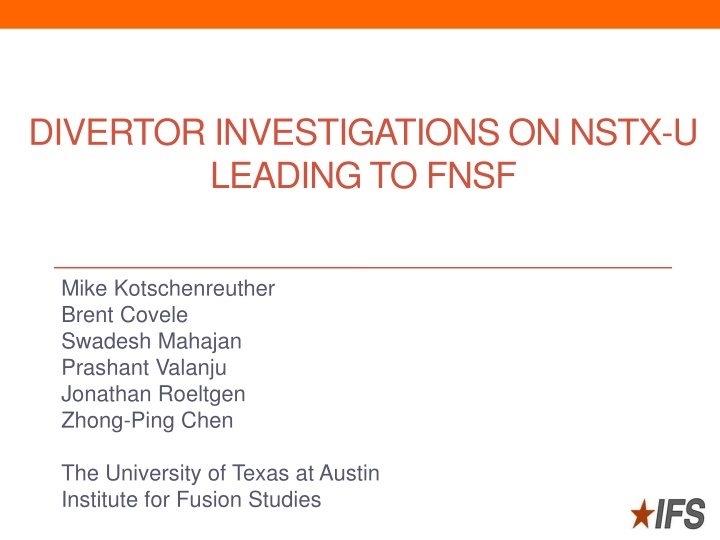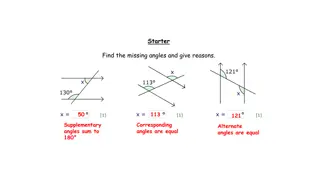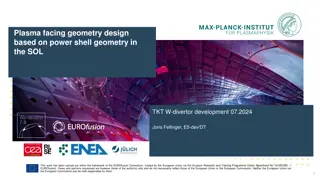Advanced Divertor Investigations on NSTX-U Leading to FNSF
Experimentally investigate advanced divertors on NSTX to design an FNSF divertor, overcoming challenges of the standard divertor. Explore divertor performance through experimental studies and comparisons of different geometries. Detachment caused instability in the standard divertor is explained heuristically.
Download Presentation

Please find below an Image/Link to download the presentation.
The content on the website is provided AS IS for your information and personal use only. It may not be sold, licensed, or shared on other websites without obtaining consent from the author.If you encounter any issues during the download, it is possible that the publisher has removed the file from their server.
You are allowed to download the files provided on this website for personal or commercial use, subject to the condition that they are used lawfully. All files are the property of their respective owners.
The content on the website is provided AS IS for your information and personal use only. It may not be sold, licensed, or shared on other websites without obtaining consent from the author.
E N D
Presentation Transcript
DIVERTOR INVESTIGATIONS ON NSTX-U LEADING TO FNSF Mike Kotschenreuther Brent Covele Swadesh Mahajan Prashant Valanju Jonathan Roeltgen Zhong-Ping Chen The University of Texas at Austin Institute for Fusion Studies
ADVANCED DIVERTOR INVESTIGATIONS ON NSTX-U Overarching goals: experimentally investigate advanced divertors on NSTX, to be able to create a validated ability to design an FNSF divertor Well known challenges of the standard divertor (SD) for STs: Low wetted area due to low R (especially with high triangularity ) => high heat flux Low connection length ( line length ); in standard models, this leads to high target plate temperature, difficulty radiating/detaching, and high erosion These challenges must be overcome by appropriate poloidal field geometries in the ST divertor advanced divertors Examine these in conjunction with Li targets another attractive solution XD, Snowflake are our primary advanced divertor geometries of interest for NSTX now
DIVERTOR PERFOMANCE- EXPERIMENTAL STUDIES AND COMPARISONS Let us, for example, label different geometries by DI (Flaring versus converging- relative to standard divertor) Flux expansion at the plate FPLATE (NOTE: flux expansion and flaring (DI) are unrelated quantities, measuring different aspects of the divertor flux surface shape) L||( connection length or line length - important in standard models) LDLEG(Length of the divertor leg in poloidal plane) What is needed is to compare the divertor properties of geometries with different DI, LDLEG, and L|| Past prediction of UT group: flux surface shape (i.e DI) is important to detachment performance (not just flux exp. Fplate)
DETACHMENT CAUSED INSTABILITY IN STANDARD DIVERTOR (HEURISTIC EXPLANATION) As the cold detachment front moves upstream, the interaction area with neutrals increases Hence, the atomic dissipation increases, which causes the temperature to get colder This positive feedback moves the cold front from the divertor to core X-point This is the edge of the H-mode- if the core boundary is cooled enough, H-mode barrier is degraded
ENABLING STABLE FULL DETACHMENT: X-DIVERTOR PRESCRIPTION Create a 2nd x-point in the SOL downstream, increasing field line flaring at the target plates Change the feedback the detachment front sees if it migrates upstream Also, line length decreases greatly as the front moves away from the plate, adding further stabilizing feedback against front migration With flared field lines, more of the radiating region stays away from the H-mode barrier- confinement degradation is avoided
DIVERTOR PERFOMANCE- DETACHMENT EFFECTS ON CONFINEMENT EXPERIMENTAL STUDIES AND COMPARISONS University of Texas: construct equilibria using CORSICA to enable experimental tests (in close cooperation with NSTX-U) Use SOLPS to both help design experiments and interpret them Experimentally test the effect of detachment on confinement for different geometries (different DI, FPLATE, L||, and LDLEG - and other parameters that may be of interest) Which geometries allow the highest detachment with the highest confinement (e.g. pedestal pressure) Which geometries allow detachment at the lowest density (for the highest current drive efficiency) Can this be achieved for low recycling Li operation? What is the effect of impurity seeding?
Recent XD experiments on DIII-D Recent XD experiment on DIII-D (D2 puffing only): Higher flaring (DI) allowed higher detachment/lower heat flux with much higher confinement (pedestal pressure) Comparison of NSTX and DIIID is very valuable- allows elucidation of effects of important variables STs naturally have much lower L|| than normal A: testing similar geometries on NSTX and DIIID allows a large variation in their values to elucidate what is important On NSTX we would like to reproduce/improve upon the DIIID results
Scan of D2 puff rates in XD and SD in DIII-D: Differences in heat flux (shown vs corresponding pedestal pressure for given puff rate) Lower DI SD comparison High DI SD comparison XD SD XD High DI: Large difference in PEDESTAL PRESSURE for low heat flux SD Lower DI: Smaller difference in PEDESTAL PRESSURE for low heat flux
Scan of D2 puff rates in XD and SD in DIII-D: Diffs in detachment (probe jsat) (shown vs corresponding pedestal pressure for given puff) High DI SD comparison Lower DI SD comparison XD SD XD SD Large difference in PEDESTAL PRESSURE for high DI Compared to SD detachment Less difference in PEDESTAL PRESSURE for low DI (Divertor Thompson-confirms w less scatter)
Important aspects of DIIID results to inform NSTX-U experiments The high DI cases that showed strong detachment with high confinement have: LESS flux expansion than the low DI (!!) Hence: flux surface flaring as parameterized by DI appears important to obtaining detachment with good H-mode confinement; NOT flux expansion The high DI case has only slightly higher L|| (~20%) than low DI possible indication L|| may not the crucial variable So, can STs with much less L|| get the same advantages from XDs as normal A? UT- construct equilibrium on NSTX-U to vary different quantities (DI, Fplate, LDLEG, and L||) to test significance experimentally Also, NSTX experiments should consider non-geometrical variables (not yet tested on DIII-D) Puffing location Seeded impurities Li vs B
NSTX-UPGRADE These are our (Brent s) initial attempts Brent has been interacting with Stefan Gerhardt and has made considerable progress in conforming to NSTX-U machine constraints Also would like to work with Egemen Kolemen in future DI best DIII-D cases
Use SOLPS to help interpret results Give simulation results as to the relative importance of L|| ,LDLEG , FPLATE Help to design NSTX experiments and interpret NSTX results
SOL MHD stability: ballooning ?? NSXT has higher SOL ideal MHD ballooning parameter than DIIID (on the outboard mid-plane) Ideal/resistive MHD could play a role in increasing turbulence at midplane OR near the plate during detachment Divertor geometry can also effect stability This could play an important role in NSTX With SOL width ~ 1/Bpol, this effect should get much stronger on the way from NSTX -> FNSF Not part of the original grant, but we are interested in developing developing a (1D) SOL ideal/resistive ballooning code This should require only modest effort but may give large impact, if instabilities are found to be strong Could be especially important for accurately projecting from NSTX to FNSF Feedback on the desirability of this from NSTX team???
CONCLUSIONS It is important to experimentally test a wide range of divertor configurations on NSTX-U Of particular importance: to demonstrate cases with strongly detached outer divertor legs along with excellent H-mode confinement Including X-divertor configurations with longer divertor legs and the 2nd X-pt near the plate Correlate SOL flux surface shape parameters with the ability to attain divertor detachment (as strong as possible) together with excellent H-mode confinement We will/are working to develop MHD equilibria to allow experimental testing of this on NSTX-U We will also employ SOLPS in the future to help in experimental design and interpretation of results
XD cases within ITER coil current limits & with baseline hardware An XD on ITER: DI=1.05 DI=1.88 DI=1.64 DI=1.74 DI=2.04 ITER X-Divertors: (a) The ITER standard divertor baseline equilibrium. (b) The original 2004 version of the ITER XD with special PF coils near the targets. (c) A 2013 XD with outer flux expansion optimized for an incident B field at 1 degree at the outer target. (d) A 2013 XD with maximal outer flux expansion within coil current limits and with 15 MA of plasma current. (e) A 2013 XD with maximal outer flux expansion within coil current limits and with 14 MA of plasma current.
Plasma and divertor parameters for the ITER X-Divertor equilibria. The minor radius was reduced in the 2013 XD plasmas to maintain 15 cm of clearance from the first wall. Confinement times are computed using the ITER98(y,2) scaling, with a density 80% of the Greenwald limit [21] and an assumed heating power of 120MW.























